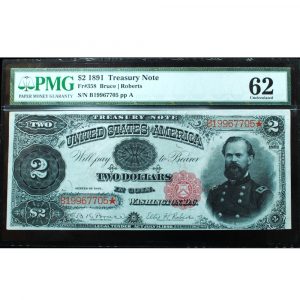Treasury Notes
Showing all 2 resultsSorted by latest
- CHOOSE A PRICE RANGE
- Product collections
- Alternative Engagement Rings
- Art Deco Jewelry (1920s-1930s)
- Art Nouveau Jewelry (1890-1910)
- Birthstone Jewelry
- Edwardian Jewelry (1901-1915)
- Estate & Vintage Jewelry
- Georgian Jewelry (1714-1840)
- Gemstone Jewelry
- Florida Fishing Jewelry
- Family Jewelry
- Retro Jewelry (1930s-1950s)
- Victorian Jewelry (1837-1901)
- GIA Certified Jewelry
- GIA Diamond Engagement Rings
- Tungsten Rings
- Stocking Stuffers
Expand Collections Condense Collections
Filter By:
- Coin GradeExpand FiltersCondense Filters
- Coin Condition
-

1891 $2 Treasury Note McPherson PMG 20 Very Fine
$1,040.00Add to cart -

1891 $2 Treasury Note McPherson PMG 62 Uncirculated
$3,600.00Add to cart
Treasury Notes
The history of U.S. Treasury Notes dates back to the 19th century, when they were first issued to fund government expenses and stabilize the economy. Initially, these notes were, in essence, promissory notes, backed by the federal government’s promise to pay the face value at a specified future date.
Over time, Treasury Notes evolved into a vital tool for regulating the U.S. economy and managing national debt. Today, they come in various forms, namely: Bills, which are short-term securities with maturities of one year or less; Notes, medium-term securities with maturities between 2 to 10 years; and Bonds, long-term securities with maturities of 20 to 30 years.
